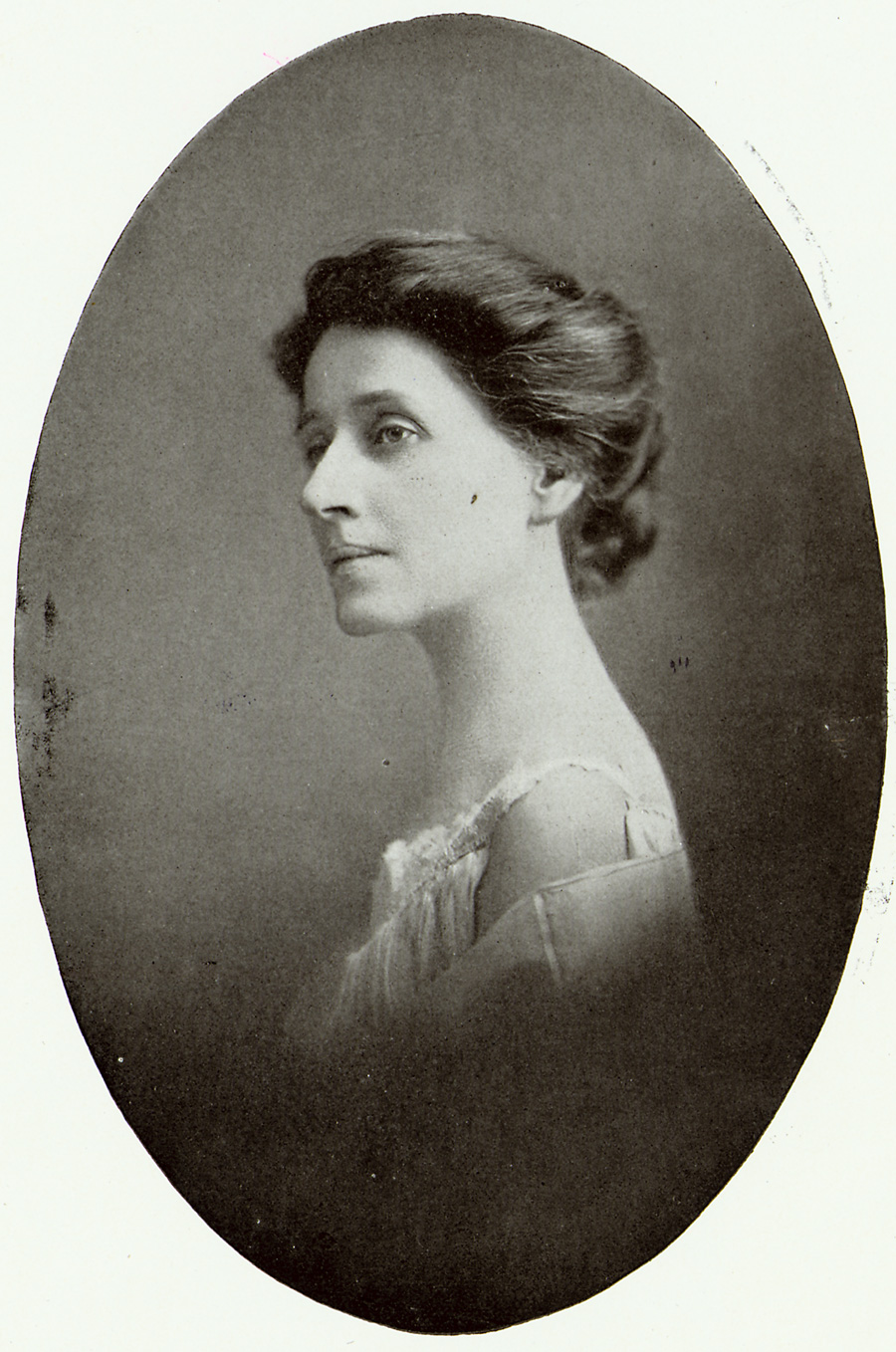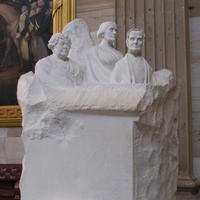More about Adelaide Johnson
Works by Adelaide Johnson

Contributor
If Adelaide Johnson had never fallen to the bottom of an elevator shaft, she may never have become “the sculptor of the women’s movement,” as she was known during her lifetime.
One cold morning in January 1882, Johnson hurried to get to her Chicago studio, hoping to start bright and early on her woodcarving and painting. Accustomed to going through the exact same routine every morning—rushing through the front doors of the building she worked in, jumping straight into its wire cage elevator, and ascending smoothly to her destination—she naturally hopped into the elevator without thinking twice. But that particular morning, it wasn’t there, and instead of being swept upward as usual, Johnson fell twenty feet. She hit the bottom of the empty shaft and was left with, to use her words, “a shattered body—bones to nerves.” Her many injuries included several dislocations, a cracked skull and elbow, and a fractured hip—the last of which left her with one leg 3 ½ inches shorter than the other. But the results of Johnson’s accident weren’t entirely awful. She was awarded $15,000 in damages, a sum which allowed her to pursue her longtime dream of studying with the masters of painting and sculpture in Europe. In Rome, she spent 11 years in the tutelage of the sculptors Guilio Monteverde and Francesco Fabi-Altini, from whom she learned the techniques that she would use in her lifelong passion: creating portrait sculptures of heroes of the 19th century women’s movement like Elizabeth Cady Stanton, Susan B. Anthony, Lucretia Mott, and many others.
This dramatic start to Johnson’s sculpting career was fitting, as this absolutely remarkable woman was well-known to have a flair for theatrics. Born Sarah Adeline Johnson, she changed her name to Adelaide at the age of 20 because she thought it sounded more striking. She shifted her age many times throughout her life too, changing it to suit her needs. In 1896, she married an English businessman named Alexander Frederick Jenkins, who was twelve years her junior. Although she claimed that the age difference didn’t matter to her (“We never either of us,” she explained, “tell our years, as we reckon not by years, but by growth,”) she nonetheless falsified her age on their marriage license, claiming that she was twenty-four instead of her actual thirty-seven, to appear younger than her new husband. The wedding, like Johnson herself, was unconventional in almost every way. It was officiated by a woman minister, which was practically unheard of at the time, and Alexander Jenkins took Johnson’s surname as “the tribute love pays to genius.” Her bridesmaids were two of her very own “white children,” which is what Johnson called her treasured marble busts of women’s rights activists.
Although her 12-year-long marriage to Jenkins began harmoniously enough, it quickly became rocky, and they separated many times before divorcing on bad terms. Not much is known about Jenkins, aside from the fact that he once spent nine months alone on a ranch in Arizona, immersing himself in solitary meditation and study. He also shared many values with Johnson—or at least he did at the start of their marriage; both were feminists, vegetarians, Christian Scientists, and Theosophists. However, as their marriage wore on, Johnson began to feel that Jenkins had lost the spiritual consciousness they’d initially shared (what could he have done to deserve such scorn?), resulting in their eventual bitter divorce.
Johnson absolutely refused to compromise when it came to her own artistic vision, resulting in her getting far less attention than she deserved during her lifetime and, sadly, being largely forgotten after her death. After an 1886 meeting of the National Woman’s Suffrage Association (NWSA), Johnson decided she would commit herself and her art 100% to the cause of the women’s movement. It was at the NWSA meeting that she first met Susan B. Anthony, who Johnson would sculpt nine busts of over the course of their friendship. But Johnson had a very high opinion of her own work, and when she was only offered $2,400 for a triad of busts she was commissioned to sculpt of Anthony, Elizabeth Cady Stanton, and Lucretia Mott, she opted not to sell them, instead keeping them in her own studio and breaking off both her friendship with Anthony and her ties to the NWSA. Sadly, the two women never reconciled, and upon Anthony’s death in 1906 their friendship still hadn’t been mended. Today, Johnson is best remembered for her reworking of these three busts into her Portrait Monument to Lucretia Mott, Elizabeth Cady Stanton, and Susan B. Anthony, which has been housed in the United States Capitol since 1921, when the National Women’s Party commissioned it in honor of the passage of the 19th Amendment, which finally gave women the right to vote.
Despite her era’s preference for bronze sculptures, Johnson went against the grain by working solely in white marble, perhaps because she sought to immortalize the remarkable women she sculpted in the same way that the statues of the ancients have been immortalized for us today. Because of her reluctance to part with her “white children” for any price that she deemed too low, Johnson sold very little of her art, and consequently had to rely on family and friends (as well as prize money that she won from appearing on several TV quiz shows) for financial support later in life. In 1939, faced with the threat of eviction for her failure to pay taxes, Johnson destroyed several of her sculptures in a protest against her circumstances, calling the press to publicize what she’d done. Her life ended on as theatrical a note as she’d lived it; thinking that it would make for good publicity, she bumped her age up to 100 when she was celebrating her 88th birthday, reversing the earlier age change she’d made on her wedding day. When she died in 1955 at the age of 96, her age was falsely reported to be 108.
Despite her adverse circumstances in later life, Johnson never regretted her choice to devote her art entirely to the cause of women’s rights—she’d seen it as her calling, and stuck to it with great determination. She regarded feminism as the most important movement one could fight for, writing that the “women’s revolution was different from other revolutions [because] it involved half of humanity against the most subtle and deeply entrenched tyranny within creation—the tyranny of sex.” Although she saw women win the right to vote during her lifetime, she knew that we still had a lot of work to do if we wanted to achieve true equality for women, a sentiment she demonstrated in her choice to leave her Portrait Monument largely unfinished. The women’s heads and shoulders just barely emerge from a huge block of unhewn marble in a striking visual metaphor for the battle for freedom and equality that we continue to fight to this day.
Sources
- “Adelaide Johnson.” A Woman A Week. Accessed October 11, 2020. http://www.awomanaweek.com/johnson.htm.
- Burton, Shirley J. To Make Immortal Their Adventurous Will. Macomb, IL: Western Illinois University, 1986.
- “Portrait Monument to Lucretia Mott, Elizabeth Cady Stanton, and Susan B. Anthony.” Architect of the Capitol. Accessed October 19, 2020. https://www.aoc.gov/explore- capitol-campus/art/portrait-monument-lucretia-mott-elizabeth-cady-stanton-and-susan
- “Sculptor Adelaide Johnson: from Illinois.” Suffrage 2020 in Illinois: The Fight for the Vote in Illinois. July 27, 2020. https://suffrage2020illinois.org/2020/07/27/sculptor-adelaide- johnson-from-illinois/.
Featured Content
Here is what Wikipedia says about Adelaide Johnson
Adelaide Johnson (1859–1955) was an American sculptor whose work is displayed in the U.S. Capitol and a feminist who was devoted to the cause of equality of women. She was known as the "sculptor of the women's movement".
Check out the full Wikipedia article about Adelaide Johnson











